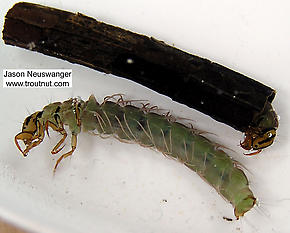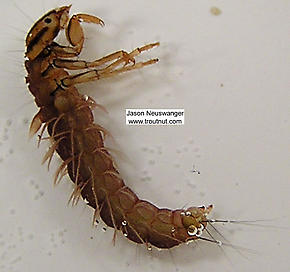Blog & Latest Updates
Fly Fishing Articles
Insects by Common Name


Caddisfly Family Phryganeidae
Taxonomic Navigation -?-
Kingdom
Animalia (Animals)
» Phylum
Arthropoda (Arthropods)
» Class
Insecta (Insects)
» Order
Trichoptera (Caddisflies)
» Family Phryganeidae
| Genus in Phryganeidae | ||
| BanksiolaTraveller Sedges | 0 | 0 |
| PhryganeaRush Sedges | 0 | 0 |
| PtilostomisGiant Rusty Sedges | 0 | 0 |
7 genera aren't included.
Where & When
Time Of Year (?): Late spring or summer
Preferred Waters: Lakes or rivers
Hatching Behavior
Pupae of this family crawl out on shore to emerge.
Egg-Laying Behavior
Females lay their eggs on the surface, and they may run across the surface to the bank. This behavior may be found throughout the family but it has earned the common name Travelling Sedges for the stillwater genus Banksiola.
Larva & Pupa Biology
Diet: Smaller aquatic insects; other food when small
Current Speed: Still or slow
Shelter Type: Leaf or bark
This is the most primitive family of case-making caddisflies, and the larvae may easily enter or leave their cases. I caught two of them in my collection container fighting over one case in a really funny video.Current Speed: Still or slow
Shelter Type: Leaf or bark
Pictures of 2 Caddisfly Specimens in the Family Phryganeidae:
Phryganeidae Caddisfly Larva View 5 PicturesThis "specimen" is actually two caddis larvae fighting each other over a case. The case is a hollow tube; one larva would go in the back end, presumably bite the other, and chase it out. The invader crawled forward into the case while the other one fled, and then it went around to the back and bit the first one. They did this several times, and I recorded it on video.
View 5 PicturesThis "specimen" is actually two caddis larvae fighting each other over a case. The case is a hollow tube; one larva would go in the back end, presumably bite the other, and chase it out. The invader crawled forward into the case while the other one fled, and then it went around to the back and bit the first one. They did this several times, and I recorded it on video.
 View 5 PicturesThis "specimen" is actually two caddis larvae fighting each other over a case. The case is a hollow tube; one larva would go in the back end, presumably bite the other, and chase it out. The invader crawled forward into the case while the other one fled, and then it went around to the back and bit the first one. They did this several times, and I recorded it on video.
View 5 PicturesThis "specimen" is actually two caddis larvae fighting each other over a case. The case is a hollow tube; one larva would go in the back end, presumably bite the other, and chase it out. The invader crawled forward into the case while the other one fled, and then it went around to the back and bit the first one. They did this several times, and I recorded it on video.Collected March 1, 2004 from unknown in Wisconsin
Added to Troutnut.com by Troutnut on January 25, 2006
Added to Troutnut.com by Troutnut on January 25, 2006
Phryganeidae Caddisfly Larva View 3 Pictures
View 3 Pictures
 View 3 Pictures
View 3 PicturesCollected March 10, 2004 from unknown in Wisconsin
Added to Troutnut.com by Troutnut on January 19, 2006
Added to Troutnut.com by Troutnut on January 19, 2006
Two Phryganeidae caddis larvae fighting over a case
Starring: Phryganeidae Caddisfly Larva
Caddisfly larvae of this family can easily leave and re-enters their cases. I caught two of them playing musical chairs or something with this one... funny!
Recent Discussions of Phryganeidae
Banksiola 4 Replies »
My understanding is the two most important species are B. selina (East) and B. crotchi (West). Supposedly of minor importance in the East but very important in certain areas of the West. Where they do occur they seem to be very abundant. Current thought in entomological circles is that selina is now synonymous with crotchi.
It's far and away the most important large stillwater caddis I've come across because of its hatching behavior. Unlike other large lake dwelling caddis I've observed, they seem to exhibit all three traits that make them valuable to anglers. It's activity is diurnal, they emerge in open water, and they do this synchronized in large numbers over several hours. It gets even better! They don't fly off but scamper across the surface until they reach shore. This trip may cover a distance covered in yards not feet (once watched one go an estimated 50 yds into shore before I lost site, hoping to see a big rise that never happened...
The best fishing is on soft evenings. Use stiff tippets and any number of green bodied deer hair winged dries in the appropriate size. Spot casting to rises or attempts to lead them usually proves futile as the fish are usually covering water pretty fast. What works for me is to cast fan fashion as far as is comfortable, stick the rod under the casting arm and strip back with both hands to avoid pauses in the retrieve while matching the speed of the natural. Hold the line delicately because the takes can be vicious! Experience has shown the fish are more selective to the appropriate motion than differentiation size or even color of pattern. Best are those designed to skate leaving the proper "V" wake and that float well.
For reasons unknown (maybe due to atmospherics messing with a clean emergence?) they will sometimes swim around in a circle whirligig fashion. On evenings when this behavior predominates, the pupa are a more consistent bet throughout the hatch, either swam shallow with a strip retrieve or raised from the bottom using a long tippet. Hard to beat the traditional Carey Special in the appropriate color for this. Unless of course, somebody can come up with a way to make their dry fly swim around in circles.
ReplyIt's far and away the most important large stillwater caddis I've come across because of its hatching behavior. Unlike other large lake dwelling caddis I've observed, they seem to exhibit all three traits that make them valuable to anglers. It's activity is diurnal, they emerge in open water, and they do this synchronized in large numbers over several hours. It gets even better! They don't fly off but scamper across the surface until they reach shore. This trip may cover a distance covered in yards not feet (once watched one go an estimated 50 yds into shore before I lost site, hoping to see a big rise that never happened...
The best fishing is on soft evenings. Use stiff tippets and any number of green bodied deer hair winged dries in the appropriate size. Spot casting to rises or attempts to lead them usually proves futile as the fish are usually covering water pretty fast. What works for me is to cast fan fashion as far as is comfortable, stick the rod under the casting arm and strip back with both hands to avoid pauses in the retrieve while matching the speed of the natural. Hold the line delicately because the takes can be vicious! Experience has shown the fish are more selective to the appropriate motion than differentiation size or even color of pattern. Best are those designed to skate leaving the proper "V" wake and that float well.
For reasons unknown (maybe due to atmospherics messing with a clean emergence?) they will sometimes swim around in a circle whirligig fashion. On evenings when this behavior predominates, the pupa are a more consistent bet throughout the hatch, either swam shallow with a strip retrieve or raised from the bottom using a long tippet. Hard to beat the traditional Carey Special in the appropriate color for this. Unless of course, somebody can come up with a way to make their dry fly swim around in circles.
Your Thoughts On Phryganeidae:
Top 10 Fly Hatches
Top Gift Shop Designs
Eat mayflies.
Top Insect Specimens
Miscellaneous Sites
Troutnut.com is copyright © 2004-2024 Jason
Neuswanger (email Jason). See my FAQ for information about use of my images.
 privacy policy
privacy policy
